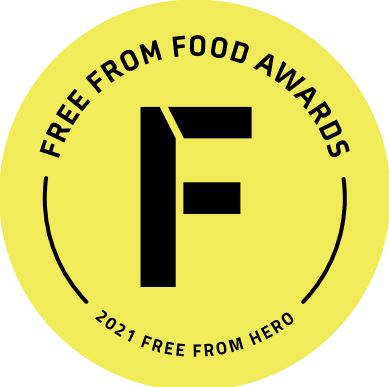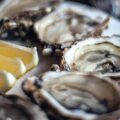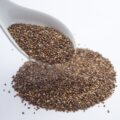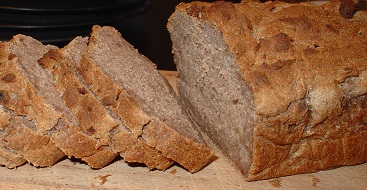Calcium propionate can be found in many gluten free baked goods and it may be the cause of many of migraine headaches. So what’s it included for? Is it really needed?

E282 – Calcium propionate
Calcium propionate “Occurs naturally in swiss cheese; prepared commercially from propionic acid. The propionates occur naturally in fermented foods, in human sweat and in digestion products of ruminants.”
Function: Preservative – antimicrobial mould inhibitor, especially those which occur in bread.
Effects: Some reports link propionate with migraine headaches. The Bakers’s Union in the UK has banned it’s use in its pure form because it provokes skin rashes in bakery workers.
Do we really need mould inhibitors in our bread? Wouldn’t you rather eat it before it got old and stale? Especially if it can cause migraines in people with already sensitive immune systems and digestion.
A study in the “Journal of Paediatric Child Health” in 2002 reported that although calcium propionate may have little to no side effects on the average person, chronic exposure, especially in children, might induce a myriad of behavioral changes. A controlled group of children fed a strict diet without any food additives was compared to a group that was given traditional bread each day. The clinical trial revealed that “irritability, restlessness, inattention and sleep disturbance in some children may be caused by a preservative in healthy foods consumed daily.” These behavioral changes appear to be reversible when the preservative is removed from the child’s diet.
Which bread has calcium propionate? So far I’ve found it to be present in Genius, M&S gluten free and Newburn Bakehouse and I’m sure others. It is also used in most normal bread and baked goods too, not just the gluten free stuff.
Can you use natural mould inhibitors?
If bakers use vinegar to clean utensils and machinery and baked goods are allowed to dry completely before being bagged there should surely be no need to added mould inhibitors.
I found this reference: “Mold inhibitors can be added to breads to lengthen their shelf life. “Natural” mold inhibitors, such as acetic acid (vinegar); raisin-juice concentrate; and glucono-delta-lactone (found in honey, fruit juices and wine) act by reducing pH to retard the initial growth of mold. The food additives propionate and sorbate are effective against mold at low concentrations, but don’t affect product pH. “Fermented wheat flour and cultured whey function as natural sources of calcium propionate,” says Beavan. Propionates and sorbates can be added into dough, batter or filling formulations. Propionates are most effective against mold and bacterial growth. Sorbates inhibit yeast as well as molds, and are used more in cakes, pies, fillings and icings. Both types can be applied as a water-based surface spray to English muffins and scones.”
If there are natural sources of mould inhibitor would they work just as well? or would vinegar for instance affect the flavour? What worries me is the quote above that fermented wheat flour and cultured whey function as natural sources of calcium propionate. Is this the kind bakers are using? Might this be causing me the nodular prurigo and eczema that I get when I eat freefrom gluten free baked goods?
I can tolerate them if I eat them in moderation but can never incorporate as a staple part of my diet. I couldn’t eat gluten free baked goods every day or my skin would be awful.
But do most people consume calcium propionate without any problems? Should I be worrying about this anyway? I guess it’s maybe just me with my ‘processed food free’ attempt at life that I wonder why these strange things are added to our food.
Can you be allergic to calcium propionate?
I couldn’t find any scientific references to allergies to calcium propionate, only some suggestions that it may cause migraines and behavioural changes. So the jury is out. I know most gluten free bread manufacturers try to keep this ingredient to a minimum but what if they stopped adding it altogether?
Would a more natural alternative work just as well?
References:
- E for Additives by Maurice Hanssen
- Livestrong
- www.foodproductdesign.com












A reader, Paul Sheehan, just emailed me with this link, that anyone worried about calcium propionate might consider reading: http://fedup.com.au/factsheets/additive-and-natural-chemical-factsheets/280-283-propionic-acid-and-its-salts-the-bread-preservative
I gave up eating foods containing gluten in March 2014, following an exceptionally severe spate of headaches. I had previously minimised consumption supermarket sliced bread and wheat-containing foods for some years, so had not had much contact with calcium proponiate. In September 2014 I began eating gluten-free breads, rolls and sandwich thins containing calcium proponiate. Almost immediately I started to suffer from severe itching on my lower legs. I blamed it on the cooler weather; possible fleas from my cat; the menopause, etc. Anything but bread, because I reasoned that g-f products must be safe, if not quite sugar-free or healthy! I made various changes such as using different topical creams, avoiding woollen clothing and hot water, etc, but still I itched and could not stop myself scratching until my skin was raw and broken down. This continued for approximately two months, and was very distressing. Eventually I read something on a google search about sulphates/sulphites, and checked out my freezer full of g-f products. Having identified C-P as a possible suspect, I decided to cut it out. I recalled recent occasions when I’d succesfully avoided scratching my legs for a couple of days, only to start again shortly after eating lunch, which contained sandwich thins with C-P as an ingredient.
Since then, 17 days ago, I have only scratched my legs once, after a very hot bath. After putting shea butter cream on the skin, it calmed down completely and I have had no itch. The skin is becoming less sensitive: dressing and undressing is no longer agony to my legs!
I emailed one of the manufacturers of g-f products, Newburn House bakery (part of Warburton’s in the UK) about their use of C-P, outlining my experience of allergic reaction. They replied promptly, but said they had no intention of removing C-P, as it was an important ingredient in keeping their products fresh.
Needless to say, I have not touched any goods with C-P in them since my discovery, and am vigilant in reading labels.
Although I have had severe headaches and occasional migraines for at least thirty years, these have dwindled to almost nothing since giving up foods containing gluten. The C-P containing foods caused me to have severely itchy skin, but not headaches. As a child, I suffered frequently from ‘mystery rashes’ usually traceable to clothing in the end, but outgrew them by the age of 13. I am, at the time of writing, 50 years old, female and perimenopausal.
I would like to spread the word about C-P to prevent anyone from having to suffer the distressing itching that I endured. The more people that know about it, the better.
WOW so your skin is much better? Mine is much better too, I’m eating a rye bread from the Village Bakery which just contains rye flour, salt and water. That’s it. Simple. I find anything processed doesn’t agree with me to be honest. I can get away with the odd lapse but cannot eat GF baked goods every day. I am sure it’s that calcium propionate.
Hi Helena.
Interesting reading on your experiences with Calcium Prpionate (cp) !! as over the last month I have started following the FODMAP after seeing my dietitian and have been seeing an improvement in my symptoms and so far I have identified I have an intolerane to fructose. Yesterday I introduced crumpets and sliced bread back into my diet and in the early hours of the morning woke up with heavy headache !! Horrible feeling through my body and IB, back to my previouse symptoms !!!!!! So googled the ingredients one of them being calcium propionate and then found your article on cp with your experience. What is also interesting is my grumpets and bread which I had yesterday are also Warburtons, so they have gone straight into the recycle bin!!!!!
Thank you
Kim. Isle of Wight ????
I’ve been eating Village Bakery rye bread which I find is OK for me and just made with rye flour, salt and water. Also Artisan Bread or ABO breads make some really different and quirky breads with none of the nasty preservatives and mould inhibitors we loathe so much. Processed food out the window. Even the birds won’t touch it. Ha Ha.
Hi Kim
No coincidence, is it? My skin continues to be fine but I’ve had a couple of items of bakery goods containing CP from my freezer this week, and have also had a nasty migraine. I might just bin the lot! I find that DS/Dietary Specials/Dr Schar goods, available in the Free From section at supermarkets, are generally free from Cp, though I still read every label. We are trying the Village Bakery rye bread, I am not sure if it’s good for me, but my partner loves it! I have noticed I can eat the pizzas at the local pub without a problem, they are made with Shiptons mill organic flour, which is a local product, stoneground in the traditional manner. I think artisan is the way to go.
Thanks for getting in touch.
Helena
All this processed stuff is bad. I have been eating Artisan Bread recently, google Artisan bread company. No preservatives. They don’t last long but cut the bread and freeze when it arrives and you can’t go wrong. I love it, it’s really tasty. Just bread also has no preservatives but not easy to get hold of.
I also have Prurigo Nodularis. I quit eating bread and 80% cleared up my PN, but it returned each time I gave in to my love of chocolate croissants or doughnuts…:( I just had a vacation in Pakistan where my PN cleared up despite the fact that I ate bread every single day! They do not use preservatives. You buy it fresh and eat it within the first hour. After this experience, my husband mentioned bread conditioners as the problem. The US allows the use of Azodicarbonamide, which disrupts the immune system, so I thought that might be the cause.
PN was discovered in 1908 by Hyde and bread conditioners were introduced in the early 1900s. Coincidence???
My daughter suffers from asthma which is brought on by Azodicarbonamide. I could not understand why her asthma had worsened, but I had chosen a bread with Azodicarbonamide, which is completely okay withe the crooked FDA in the US, even though factory workers get asthma working with the stuff.
And, I have a son who gets migraines, so I am going to take him off calcium proprionate.
If you need to rid yourself of PN, dry it out by taking baths with dettol and once you are dry, put hemp oil or hemp lotion. It dries it up and the skin heals beautifully. It takes 2 weeks to heal.
You can also buy cbd (cannabinoids) in gummy form online without thc to help heal your body from the “invasive chemical.” It has the same effect as hemp. I have not tried it, but hope to soon. Good luck!
WOW! Thanks for the response. I too know mine is directly caused by something in processed food and often freefrom bread. I wouldn’t be at all surprised if it was one of those ingredients for me too. I just succumbed to some GF crumpets which were amazing, but the PN has come back. No surprise there then. I use teatree oil neat in a bath and then use Pure Potions to moisturise after. Works for me too.
I bought a bread maker out of self-defense. because I love bread! That will stop me from giving in to my craving…
If I cannot change the FDA’s approval of Calcium Proprionate, which is also used in Canada, the bread companies like Sara Lee, Pepperidge Farm (which sounds so wholesome) do not need my money!
My nephew died at 13. The family ate Sara Lee bread. He mysteriously became allergic to more and more foods, which is a sign of azodicarbonamide, so I think he just ate a piece of Sara Lee bread and it killed him. The doctor had no idea what he died of, so he said he “became allergic to his inhaler” isn’t that lucky for Sara Lee?
How many other asthmatics are eating Sara Lee and Pepperidge farm and are making their child’s asthma worse without knowing it? Because they trust the FDA to do it’s job???
Since I started making my bread or giving my asthmatic daughter Dave’s Killer bread (no preservatives,), she has not used her puffer. But, after arriving in the US, we bought her a Burger King burger and right after she had that, she had touse her inhaler because she felt so tight. Now I know that Burger King, MacDonald’s, Chick Fil A and most fast food companies use it except Subway. I was avoiding it, because of the bread, but it seems that I can have one fast food!
One website admitted that Calcium Proprionate may cause migraines, but as long as it’s not toxic, they don’t care! Despite the myriad of chemicals put in, somehow migraine victims are supposed to divine what causes the migraine and avoid it. Our doctor almost laughed when we asked what caused my son’s migraines. She just said “there are so many things.” But if it is something you eat everyday you would stop doing it, of course.
If you eat a food with msg or any chemical that does not agree with you, take Nux Vomica, the homeopathic medicine, to take away the bad effects. We did take out, it gave me a migraine, (I suspect msg) and after 2 doses, I was fine!
Does high fructose corn syrup cause an outbreak for you? Is it used where you are?
Hi Alison, gosh what a lovely long comment. I am sorry to hear about your nephew. Asthma is a killer and often not well controlled. I am trying to avoid all baked freefrom goods at the moment because it does affect my skin, not sure about my breathing but i’ll try to take note and see. I think we will pay the price in years to come for the consumption of so much fake, artificial man made ingredients as those you mention above. And re corn syrup, I think we do have this in the UK but I don’t think I react to it. I have a few problematic things that I’ve not pinned down any further just ‘fast food that’s freefrom or processed’ and which ingredient that’s common to them all I’m non the wiser about.